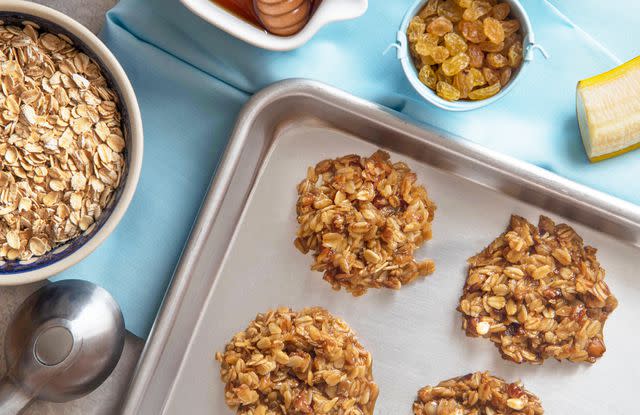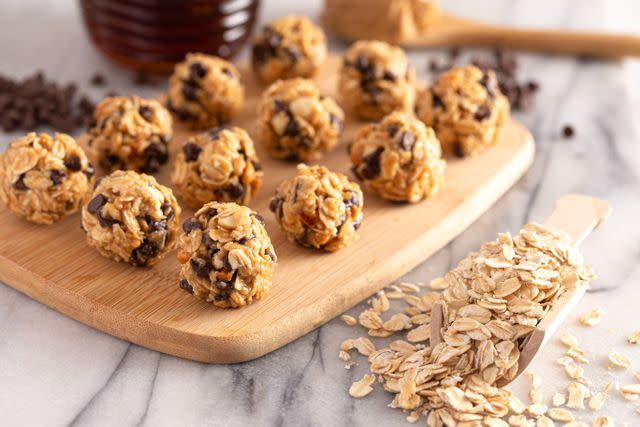Rolled Oats vs. Old-Fashioned Oats: Quaker Oats Explains the Difference
The answer might surprise you.

Simply Recipes / Getty Images
For a food that is so simple in some ways, oats are oddly confusing when it comes to the different labels you see on the packaging and the wording found in recipes. This is the one I find most confusing: Many recipes for overnight oats, oatmeal cookies, and oat-topped crisps call for "rolled oats" or "old-fashioned oats."
Until recently, I had no idea why a recipe might call for one or the other. So I did a little sleuthing on oats and found answers that surprised me. Here's what I learned.
What's the Difference Between Old-Fashioned Oats and Rolled Oats?
Good news: If you are about to start a recipe that calls for "rolled oats" and you only have oats labeled "old-fashioned"—or vice versa—there's no need to run to the grocery store or abandon your recipe.
That's because rolled oats and old-fashioned oats are the same thing, according to the Quaker Oats website. So you should feel free to sub one for the other.
Rolled oats get their name from being flattened with rollers. They cook quickly—in about 10 to 15 minutes—and maintain some structure and bite. These are the reasons old-fashioned oats are a great go-to for bowls of oatmeal and overnight oats as well as all sorts of baked goods, including cookies, muffins, and granola bars. If you see a recipe that just calls for "oats," chances are it means old-fashioned/rolled oats.
However, before you start swapping out other types of oats in recipes, it's important to understand the distinction between rolled and old-fashioned oats versus other types of oats—because haphazardly swapping them for, say, steel-cut or instant oats can mess up your recipe.

Simply Recipes / Getty Images
Other Types of Oats
Here are other types of oats you'll find at the store, plus the best uses for each of them.
Instant Oats: Instant oats are frequently sold in individual-serving packets in plain and flavored varieties. They are a type of rolled oats, but even thinner and more finely chopped. You cook them by pouring boiling water or hot milk over them and waiting about a minute, or zapping them in the microwave with water or milk for a minute or two.
While instant oats are convenient, some people find them unappealingly mushy, and their fine texture means they shouldn't be used in baked goods. However, if a recipe specifically calls for instant oats, go ahead and use them!
Read More: Grace Elkus's 3-Ingredient Skillet Apple Crisp (with Instant Oats)
Quick Cooking Oats: Between instant and old-fashioned oats are quick oats or quick cooking oats, which are a type of rolled oats that you can cook on the stovetop or in the microwave for a minute or three. They have a smoother, finer texture than regular rolled oats but aren't quite as fine as instant oats. In addition to making oatmeal with quick oats, you can also use them as a binder in meatloaf and meatballs.
Steel-Cut Oats: On the opposite end of the spectrum from instant oats are steel-cut oats. Rather than being rolled, they're made by chopping whole oats into small pieces with—you guessed it—a steel blade. They take 20 to 30 minutes or longer to cook, and make for a delicious chewy porridge that's wonderful with brown sugar, maple syrup, or molasses and milk, cream, crème fraîche, or buttermilk, along with toppings like nuts and dried fruit. You may find them labeled as Irish oats or pinhead oats.

Simply Recipes / Getty Images
The Takeaway
Rolled oats—also known as old-fashioned oats—are a versatile ingredient that can be used for oatmeal and in all sorts of recipes. If you want something that cooks in one to three minutes, opt for instant or quick oats. However, if you want a toothsome and tasty porridge and have time to spare, choose steel-cut oats.
Read the original article on Simply Recipes.

